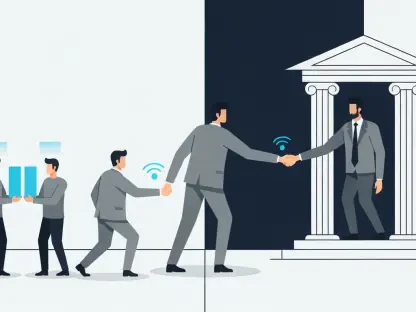In an era where financial transactions demand speed, transparency, and cost efficiency, a major traditional banking giant has taken a bold step into the realm of blockchain technology, sparking curiosity about the future of global payments. Bank of America, one of the largest financial institutions in the world, has partnered with Ripple to integrate the RLUSD stablecoin into its internal payment systems. This collaboration marks a significant shift, as it showcases how a legacy bank is embracing digital assets to modernize operations and meet evolving market demands. Far from the speculative reputation often tied to cryptocurrencies, stablecoins like RLUSD—pegged 1:1 to the U.S. dollar—offer a practical solution for real-world financial challenges. This move not only highlights a growing acceptance of blockchain in mainstream finance but also sets a potential precedent for other institutions to follow, reshaping perceptions of digital tools in corporate banking.
Transforming Banking Operations
Enhancing Efficiency with Blockchain Technology
The integration of Ripple’s RLUSD stablecoin into Bank of America’s payment infrastructure represents a transformative leap in how financial transactions are processed at an institutional level. By leveraging blockchain technology, the bank can achieve near real-time payment finality, a stark contrast to the delays often experienced with traditional systems that rely on intermediary correspondent banks. This capability significantly reduces transaction times, allowing for faster settlements in corporate finance operations. Additionally, the use of RLUSD lowers costs by minimizing the fees associated with multiple intermediaries, while the immutable nature of blockchain records enhances auditability. These improvements are critical for optimizing capital allocation and managing global liquidity, especially for a bank with vast international operations. As customer demand for seamless and efficient transactions grows, this partnership positions Bank of America as a forward-thinking leader in adopting cutting-edge solutions to address longstanding inefficiencies in the financial sector.
Redefining Global Payment Systems
Beyond immediate operational benefits, the collaboration between Bank of America and Ripple signals a broader redefinition of global payment systems through digital innovation. The RLUSD stablecoin facilitates direct settlements on Ripple’s scalable infrastructure, bypassing the complexities of legacy cross-border payment networks that often involve multiple parties and currencies. This streamlined approach not only enhances transparency but also provides a stable medium for transactions, given the stablecoin’s pegged value to the U.S. dollar. For multinational corporations and clients, this means more predictable and reliable financial interactions, fostering greater trust in digital tools. Moreover, the partnership validates the credibility of stablecoins as viable instruments in traditional finance, potentially encouraging other Tier-1 banks to explore similar integrations. As blockchain continues to gain traction, this initiative could serve as a blueprint for modernizing payment ecosystems, aligning with the industry’s push toward faster and more accessible financial services worldwide.
Navigating Challenges and Future Potential
Addressing Regulatory and Security Concerns
While the partnership between Bank of America and Ripple holds immense promise, it is not without significant challenges, particularly in the realms of regulation and security within the financial sector. Navigating complex regulatory frameworks remains a critical hurdle, as digital assets like RLUSD must comply with stringent guidelines to ensure consumer protection and financial stability. Proactive engagement with regulators is essential to establish clear policies that support innovation while mitigating risks. Additionally, security concerns around blockchain technology, such as potential vulnerabilities in digital transactions, require robust safeguards to maintain trust. Bank of America’s adoption of RLUSD underscores the importance of transparency in addressing these issues, ensuring that every transaction is traceable and secure. Balancing technological advancement with compliance will be key to the long-term success of stablecoin integration, setting a standard for how traditional finance can responsibly embrace decentralized systems in a heavily regulated environment.
Pioneering a Digital Financial Ecosystem
Looking ahead, the collaboration between Bank of America and Ripple stands as a pioneering effort in building a more digitized financial ecosystem with far-reaching implications for the industry. This partnership reflects a growing confidence in blockchain-based solutions to address market needs, especially in the area of cross-border payments where inefficiencies have long persisted. The successful implementation of RLUSD could inspire other legacy banks to partner with technology providers, accelerating the shift toward digital transformation across the sector. Furthermore, as public perception of digital assets evolves from speculative to practical, stablecoins may become integral to mainstream finance, bridging the gap between traditional and decentralized systems. The momentum generated by this initiative suggests a future where financial institutions increasingly rely on innovative tools to enhance service delivery. By taking these initial steps, Bank of America and Ripple have laid the groundwork for a wave of modernization that could redefine global banking for years to come.









